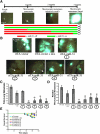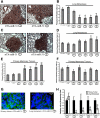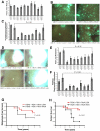Activation of miR-31 function in already-established metastases elicits metastatic regression
- PMID: 21406558
- PMCID: PMC3059837
- DOI: 10.1101/gad.2004211
Activation of miR-31 function in already-established metastases elicits metastatic regression
Retraction in
-
Retraction: Activation of miR-31 function in already-established metastases elicits metastatic regression.Genes Dev. 2015 Mar 15;29(6):686. Genes Dev. 2015. PMID: 25792603 Free PMC article. No abstract available.
Abstract
Distant metastases, rather than the primary tumors from which these lesions arise, are responsible for >90% of carcinoma-associated mortality. Many patients already harbor disseminated tumor cells in their bloodstream, bone marrow, and distant organs when they initially present with cancer. Hence, truly effective anti-metastatic therapeutics must impair the proliferation and survival of already-established metastases. Here, we assess the therapeutic potential of acutely expressing the microRNA miR-31 in already-formed breast cancer metastases. Activation of miR-31 in established metastases elicits metastatic regression and prolongs survival. Remarkably, even brief induction of miR-31 in macroscopic pulmonary metastases diminishes metastatic burden. In contrast, acute miR-31 expression fails to affect primary mammary tumor growth. miR-31 triggers metastatic regression in the lungs by eliciting cell cycle arrest and apoptosis; these responses occur specifically in metastases and can be explained by miR-31-mediated suppression of integrin-α5, radixin, and RhoA. Indeed, concomitant re-expression of these three proteins renders already-seeded pulmonary metastases refractory to miR-31-conferred regression. Upon miR-31 activation, Akt-dependent signaling is attenuated and the proapoptotic molecule Bim is induced; these effects occur in a metastasis-specific manner in pulmonary lesions and are abrogated by concurrent re-expression of integrin-α5, radixin, and RhoA. Collectively, these findings raise the possibility that intervention strategies centered on restoring miR-31 function may prove clinically useful for combating metastatic disease.
Figures







References
Publication types
MeSH terms
Substances
LinkOut - more resources
Full Text Sources
Other Literature Sources
Medical
